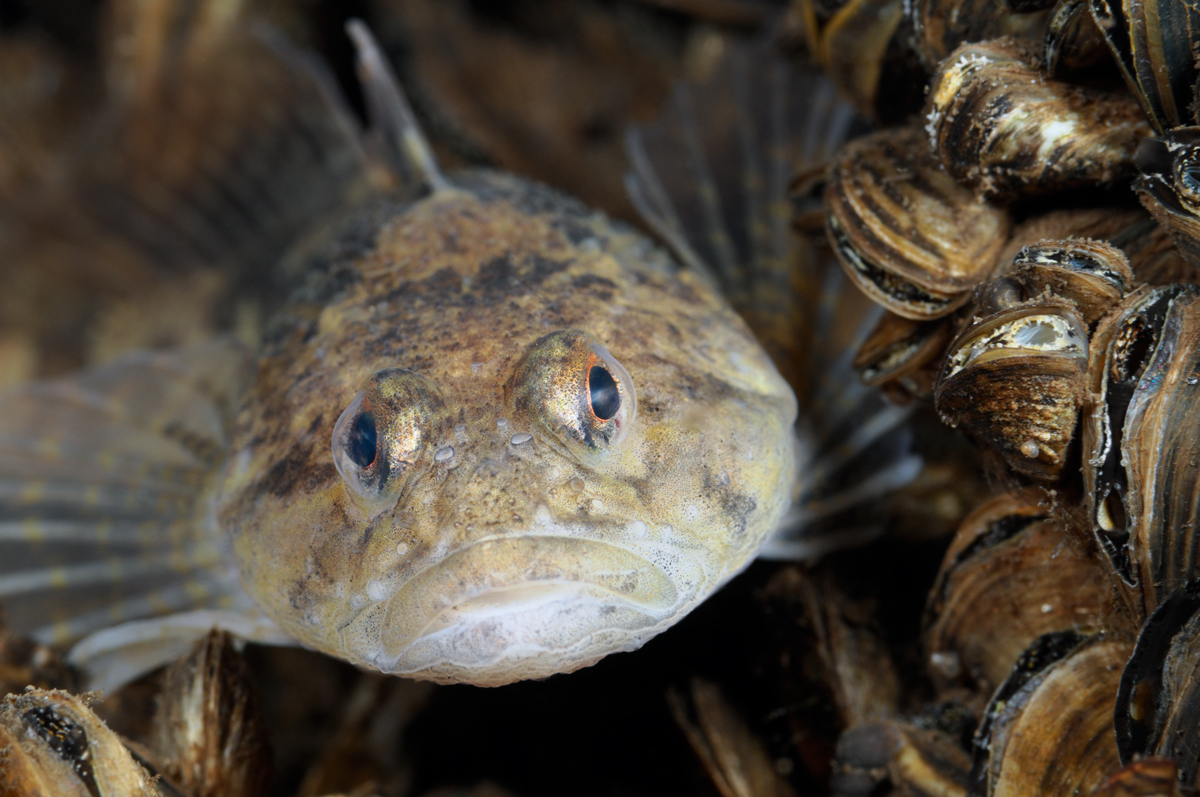

13 januari 2016, een koud nachtduikje in de Boschmolenplas. Gewapend met camera, de 105 lens en +15 wet-lens te water. Tijdens een winterse nachtduik zitten er altijd veel marmergrondels. We gaan richting zeilboot want op het dek, beter gezegd, wat er nog van over is, liggen er altijd een aantal. Helaas hebben ze een afkeer van licht zodat een foto maken tijdens een nachtduik niet altijd even makkelijk is. Gelukkig blijft er dit keer eentje liggen maar na twee foto’s is ook hij verdwenen.
Twee dagen later worden de foto’s naar de computer overgezet en tot mijn grote verbazing staat er helemaal geen marmergrondel op. Goed kijken en nog eens goed kijken, ja, het is toch echt een rivierdonderpad (Cottus perifretum). Ik heel erg blij want een rivierdonderpad had ik in de Boschmolenplas nog nooit gezien. De volgende nachtduikjes dus maar op zoek naar de donderpad. Na meerdere nachtduikjes blijft de teller op 2 donderpadden staan.
20 maart 2016, een koud duikje in de Boschmolenplas. Gewapend met camera, de 105 lens en +15 wetlens te water. Even wennen aan de temperatuur want het water wil maar niet warmer worden. Een Naturalis medewerker is geïnteresseerd in een bepaald soort platworm die in de Boschmolenplas voorkomt. Meestal vinden we hem al bij de instap dus daar beginnen we maar met zoeken.
Hij zit er, goed nieuws voor de Naturalis medewerker. We snuffelen nog wat rond en ja, daar zijn ze dan, de eerste eitjes van het jaar. Ik heel erg blij want deze eitjes had ik in de Boschmolenplas nog nooit gezien. Ik had ze zelfs nog niet op foto. Ronde vorm, roze en wit van kleur dus twee legsels. Jiiiippppiiieee, het zijn de eitjes van de donderpad. Terwijl ik dit denk zie ik mannetjesdonderpad ook liggen. Ze bewaken het nest nadat een of meerdere vrouwtjes eieren gelegd hebben. We maken snel nog enkele foto’s en laten het nest dan met rust want mannetjesdonderpad wordt zenuwachtig. Een donderpaddennest in de Boschmolenplas, en dan nog met twee verschillende legsels, heel bijzonder.
Door de komst van exoten zoals marmer- en zwartbekgrondel gaat de donderpaddenstand steeds verder achteruit. Marmergrondel en donderpad kunnen, hoewel moeizaam, nog wel samen leven. Verschijnt eenmaal de zwartbekgrondel, dan is het snel gedaan met de donderpad, helaas. Gelukkig is de zwartbekgrondel nog niet aanwezig in de Boschmolenplas. Hoewel er niet zo heel veel donderpadden in de Boschmolenplas leven planten ze zich dus wel voort. Vraag is: zijn ze samen met marmergrondel via de pijp de Boschmolenplas ingespoeld, erg onwaarschijnlijk. Zijn ze uitgezet, onwaarschijnlijk. Of hebben we de donderpad al die jaren toch over het hoofd gezien?

Tekst en foto’s, Silvia Waajen
January 13th 2016, a cold night dive in the Boschmolenplas. Armed with camera, the 105 lens and +15 wet lens we go into the water. There are always lots of Tubenose goby’s during a winterly night dive. We’re going to the sailing boat because on the deck, anyway what’s left of it, are always lots of them. Unfortunately they dislike light so making a picture during a night dive is not always easy. Fortunately this time one stays but after two pictures he is also gone. Two days later the pictures are transferred to the computer and to my big surprise there is no Tubenose goby at all on the picture. Good look, again a good look, yes, it really is a Bullhead (Cottus perifretum)). I, very happy because I had never seen a Bullhead before in the Boschmolenplas. So the next night dives we’re searching for the Bullhead. After some more night dives the Bullhead count stops at two.
March 20th 2016, a cold dive in the Boschmolenplas. Armed with camera, the 105 lens and +15 wet lens we go into the water. We have to get used to the temperature for a few seconds, the water doesn’t want to get warmer. A Naturalis employee is interested in a special kind of flatworm that’s living in the Boschmolenplas. Most of the time we find this flatworm at the entrance so we start searching here. He is there, good news for the Naturalis employee. We look around for a little while and yes, there they are, first eggs of the year. I, very happy because I had never seen these eggs before in the Boschmolenplas. I didn’t even have them on pictures. Round shape and pink and white so two different egg clutches. Yesss these are Bullhead eggs. I spot the male Bullhead while I’m thinking this. The males guards the nest after one or more females laid eggs. We leave the nest after a few quick pictures because male Bullhead is getting nervous. A Bullhead nest in the Boschmolenplas, with two different egg clutches, very special.
With the arrival of invaders like the Tubenose- and Round goby the amount of Bullhead is declining. Tubenose goby and Bullhead can, although hardly, live together. Unfortunately the Bullhead will be driven to extinction when the Round goby appears. Fortunately the Round goby isn’t present in the Boschmolenplas yet. Although there aren’t much Bullheads in the Boschmolenplas, they do reproduce. The question is: are they together with the Tubenodsegoby flushed into the Boschmolenplas trough the pipeline, very unlikely. Are they released into the Boschmolenplas, unlikely. Or have we just overlooked the Bullhead for all these years?
Zorgeloos duiken en snorkelen begint bij Scuba Adventures Europe. Wij helpen jou de onderwaterwereld te ontdekken met een duikuitrusting die naadloos aansluit op jouw wensen en behoeften.
In onze online en offline duikwinkels vind je als duiker alle benodigdheden om van iedere duik een onvergetelijke ervaring te maken.